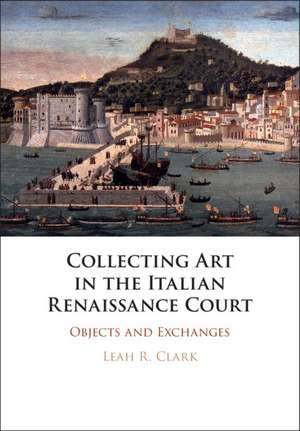Collecting Art in the Italian Renaissance Court: Objects and Exchanges
Autor Leah R. Clarken Limba Engleză Hardback – 27 iun 2018
Preț: 708.42 lei
Preț vechi: 795.98 lei
-11% Nou
Puncte Express: 1063
Preț estimativ în valută:
135.60€ • 147.34$ • 113.98£
135.60€ • 147.34$ • 113.98£
Carte tipărită la comandă
Livrare economică 22 aprilie-06 mai
Preluare comenzi: 021 569.72.76
Specificații
ISBN-13: 9781108427722
ISBN-10: 1108427723
Pagini: 338
Ilustrații: 57 b/w illus. 8 colour illus.
Dimensiuni: 183 x 261 x 20 mm
Greutate: 0.9 kg
Editura: Cambridge University Press
Colecția Cambridge University Press
Locul publicării:New York, United States
ISBN-10: 1108427723
Pagini: 338
Ilustrații: 57 b/w illus. 8 colour illus.
Dimensiuni: 183 x 261 x 20 mm
Greutate: 0.9 kg
Editura: Cambridge University Press
Colecția Cambridge University Press
Locul publicării:New York, United States
Cuprins
1. Carafa's testa di cavallo: the life of a bronze gifthorse; 2. Practices of exchange: merchant bankers and the circulation of objects; 3. Intertextuality and collection at the court of Ferrara: Roberti's Diptych; 4. The Order of the Ermine: collars, cloaks, and the circulation of the sign.
Recenzii
'Clark shows that diplomatic, economic and dynastic links between fifteenth-century Italian Renaissance elites were sustained by the circulation of art objects: not just traditional paintings and sculptures, but objects of symbolic and material value as heraldic collars, jewels, furniture, and textiles. In their circulation as gifts between influence-brokers and powerful individuals, these prestige commodities acquire social and cultural biographies and sustain layers of complex interpretation that have a crucial bearing on the selfhood and agency of their owners. Clark's indispensable new study is especially to be welcomed for its attention to the court of Naples, neglected in anglophone scholarship, and here shown to be crucial to the statecraft of Ferrara and Florence.' Stephen Campbell, The Johns Hopkins University
'In this illuminating book, Leah R. Clark shows that objects in princely collections did much more than reflect the magnificence of the ruler. Works of art in whatever media - including books, textiles, medals and gems as well as paintings and sculpture - interacted with each other in complex webs of intertextuality. As the fascinating case-studies indicate, the meaning of objects was inherently unstable. When given away, borrowed, bought, or pawned, they acquired shifting cultural dimensions. Their value was continually renegotiated through diplomacy, social display, or private study and contemplation, while their significance depended just as much on their dialogues with each other, and with their owners, as on their individual appearance, subject matter, materials and workmanship. This perceptive reinterpretation casts new light on the dynamics of court culture in the Italian Renaissance.' Deborah Howard, Professor Emerita of Architectural History, University of Cambridge
'Collecting Art in the Italian Renaissance Court: Objects and Exchange offers both scholars and students of art history an invaluable insight into the complex web of connections facilitated by a range of objects in Early Modern Italy - it is essential reading for anyone interested in the narratives built around art objects.' Marika Leino, Oxford Brookes University
'Clark's book is manifestly successful when it lets her strategically chosen case studies shine in their particularity. Her fine-grained research is new, and it demonstrates how objects could operate in different roles in Quattrocento Italy.' Gail Feigenbaum, Renaissance Quarterly
'Taking objects - as opposed to people - as her protagonists, Leah Clark proposes an innovative approach to the history of collecting art in fifteenth-century Italian courts … the scope of Clark's book reaches well beyond collecting.' Gail Feigenbaum, Renaissance Quarterly
'In this illuminating book, Leah R. Clark shows that objects in princely collections did much more than reflect the magnificence of the ruler. Works of art in whatever media - including books, textiles, medals and gems as well as paintings and sculpture - interacted with each other in complex webs of intertextuality. As the fascinating case-studies indicate, the meaning of objects was inherently unstable. When given away, borrowed, bought, or pawned, they acquired shifting cultural dimensions. Their value was continually renegotiated through diplomacy, social display, or private study and contemplation, while their significance depended just as much on their dialogues with each other, and with their owners, as on their individual appearance, subject matter, materials and workmanship. This perceptive reinterpretation casts new light on the dynamics of court culture in the Italian Renaissance.' Deborah Howard, Professor Emerita of Architectural History, University of Cambridge
'Collecting Art in the Italian Renaissance Court: Objects and Exchange offers both scholars and students of art history an invaluable insight into the complex web of connections facilitated by a range of objects in Early Modern Italy - it is essential reading for anyone interested in the narratives built around art objects.' Marika Leino, Oxford Brookes University
'Clark's book is manifestly successful when it lets her strategically chosen case studies shine in their particularity. Her fine-grained research is new, and it demonstrates how objects could operate in different roles in Quattrocento Italy.' Gail Feigenbaum, Renaissance Quarterly
'Taking objects - as opposed to people - as her protagonists, Leah Clark proposes an innovative approach to the history of collecting art in fifteenth-century Italian courts … the scope of Clark's book reaches well beyond collecting.' Gail Feigenbaum, Renaissance Quarterly
Notă biografică
Descriere
This book presents a new perspective on the Italian Renaissance court by examining the circulation, collection and exchange of art objects.
